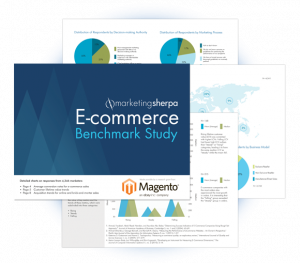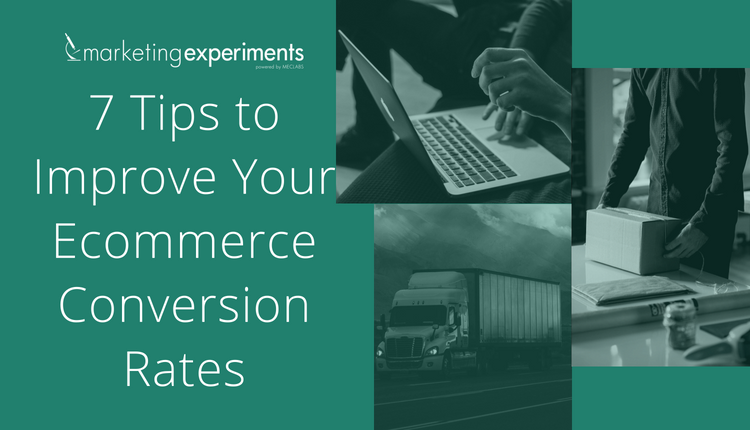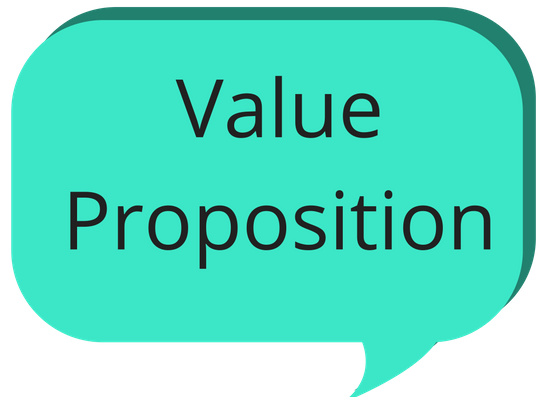We recently published median conversion rates for 25 ecommerce product categories in MarketingSherpa (MarketingExperiments’ sister publication).
That answers the first question most marketers have — how are my conversion rates compared to my competitors?
But the quick second question should be — how do I improve my conversion rates?
 To tackle that topic, we look back at the original research that informed those benchmark conversion rates — The MarketingSherpa E-commerce Benchmark Study. In the study, we asked for quantitative information, like average conversion rates. But we also had free response fields where marketers could enter qualitative information as well.
To tackle that topic, we look back at the original research that informed those benchmark conversion rates — The MarketingSherpa E-commerce Benchmark Study. In the study, we asked for quantitative information, like average conversion rates. But we also had free response fields where marketers could enter qualitative information as well.
In this article, we’ll go through some of that qualitative information, along with resources to help you put it into practice.
Tip #1: Conversion rate improvements are a continual process
Here are some thoughts from respondents …
“[Our challenge is] conversion rates … we have been making improvements in the website and our conversion rate is steadily climbing.”
“Current version of website is 2 years old. In the process of a re-build to enhance PPC and organic conversions.”
“Quickly changing landscape with our competitors, mainly in look and feel of sites. We’ve hired a conversion optimization team to assist with a website overhaul.”
“Revised and tested landing pages over and over again.”
Conversion rate optimization (CRO) is the continual process of making changes, testing them, learning from them, and make further improvements based on new knowledge.
It is continual. A website isn’t like a brochure that is fixed. The internet is constantly changing, and those changes can affect your site’s conversion from a Google algorithm change to a suddenly slower-loading plug-in on your site to shifting consumer preferences and whims.
Here are some resources on CRO:
- Marketing 101: What is CRO (Conversion Rate Optimization)?
- MarketingSherpa Quick Guide to Conversion Rate Optimization: 9 tactics to ensure you are running valid tests
- Conversion Rate Optimization: Getting The Right “Yes”
Tip #2: Optimize your call-to-action
“We have seen improvements in the conversion rates by reducing clicks and improving CTAs [calls-to -action]. Instead of ‘View,’ we used ‘Buy’ and that proved to be a stronger CTA for conversions.”
The call-to-action can have a large impact on conversions since it is the point of decision for the customer. Just don’t run out and change your CTA from ‘view’ to ‘buy’ and accept a similar conversion increase.
In fact, we’ve run many experiments where we’ve seen that asking for more commitment in the CTA can drive down conversion. But it depends on the buyer’s journey. In the example from these marketers, they might have already been far down the buyer’s journey. Or they may simply be paying for clicks in an ad and only want to pay for very qualified traffic that will purchase. However, if you’re optimizing the CTA in the first email your prospect sees, a CTA of “Buy” may be asking too much too soon.
So test and see what works for your unique customers. And don’t assume the same CTA will be most effective in different stages of the buyer’s journey. Understand where the customer is at in their thinking, and what the most logical next step is.
Here are a few resources to help you optimize your CTAs:
- Web Optimization: Simple CTA Change Increases Conversion 77%
- Effective CTAs: How The Thought Sequence Of A Call-To-Action Affects Landing Page Performance
- 5 Common Call-To-Action Errors
Tip #3: Communicate your brand’s and products’ unique value proposition
“It is difficult to increase conversion rate without using incentives like discounts and offers.”
Yes, it certainly is. That’s why so many marketers revert to using discounts and offers. It’s a way to juice short-term results.
But selling on cost reduction alone is a difficult way to run a sustainably profitable business.
The answer to overcoming this challenge is the value proposition. If your product provides a true value to potential customers, and you do a good job of clearly articulating that value in a compelling way, you are more likely to be able to sell on value and not just cost reduction — increasing conversion rates and your margins.
A few helpful resources:
- Powerful Value Propositions: How to optimize this critical marketing element – and lift your results
- Customer Value: The 4 Essential Levels Of Value Propositions
- Incentive: The Bacon Of Marketing Tactics
- Incentive: Cause Marketing Generates 7x More Revenue Than Price Discounts For Toy Manufacturer
Tip #4: Make it easy for the customer
“It is obvious, but worth mentioning: making the eCommerce experience as simple as humanly possible.”
A well-articulated value proposition increases the likelihood of conversion, while friction decreases the likelihood of conversion.
You may have all sorts of internal policies, technological challenges or good faith reasons why the buy process is difficult for the customer. But those internal reasons don’t matter. The more friction there is, the more likely the customer will find someplace else to purchase (like that streamlined efficiency monster Amazon).
Here are a few resources to help you reduce friction:
- Friction: 3 Simple Optimization Tactics To Get More Customers From Headline To Call-To-Action
- Landing Page Optimization: Identifying Friction To Increase Conversion And Win A Nobel Prize
- Hidden Friction: The 7 Silent Killers Of Conversion
This doesn’t mean your website can’t convert despite friction. There are other factors at play to optimizing conversion, as shown in the MECLABS Conversion Sequence Heuristic. But reducing friction will usually increase conversion. For example, this respondent was wise enough to know that while the site was converting well, friction was hampering the conversion rate.
“Our conversion rate is surprisingly good for a website that requires users to register before checking out.”
Tip #5: Less can be more
Another way to reduce friction is reducing the steps necessary to make a purchase, as this respondent describes. This is a common problem in ecommerce purchase funnels.
“Our conversion funnel from Cart Start to Purchase confirmation was a disaster. Too many steps, too much abandonment, and not enough messaging within the funnel to help the customer navigate. We did some thorough analysis on our purchase funnel. We identified all the major drop-out points (abandonment) and identified steps that could either be eliminated, skipped or consolidated. Our purchase funnel went from 12 steps down to six. We still have some testing and optimizing to do.”
Some ideas to help you remove steps that are hindering conversion in your funnel:
Tip #6: You don’t only need a clear value prop for customers, you need that clear value prop for internal and external decision makers as well
“Most of our clients only want a website. And most all of our clients have no understanding of the importance of creating a strategic marketing plan that integrates the website as a part of a traffic and conversion process. They also don’t understand the value and benefits of analytical tools on the back end to measure results and to modify marketing campaigns and testing for better conversion.”
Some marketers are so focused on selling to an end customer, they overlook the internal marketing that is crucial to any campaign or website’s success as well. For some reason, we get frustrated and think internal business decision makers or external clients should just get it.
Even though our art is communication and conversion, when it comes to those closest to us, we overlook the essential need to present a value proposition.
Here are a few ideas to help with your internal marketing:
- Internal Marketing: The 3 People You Must Sell To In Your Own Office
- Marketing Career: Crafting an internal performance whitepaper
- 5 steps to telling your team’s story internally
Tip #7: Understand the conversion you need before the conversion you want
Optimizing conversion rate shouldn’t only be about the final sale. The marketer quoted below has done a good job understanding the necessary micro-yes that ultimately leads to higher sales — opt-ins to an email newsletter.
“We have three key items we check almost daily: number of visitors, conversion rate, and average order value (AOV). Where we see that number of visitors is increasing, conversion rate and AOV is more or less stable. By far, our most successful marketing instrument is our weekly newsletter with some special offers. That boosts sales dramatically. So we are also quite keen on having customers sign up for the newsletter.”
Some resources to help you understand the micro-yes sequence:





Optimization and conversion rate are buzzwords that are easy to find but can be tricky to implement without a plan and clear objectives. To be clear, optimization is the process of making changes and tweaks to your site to make it better, more visible and more user-friendly to site visitors. Conversion rate optimization specifically deals with changes you can make to your site to encourage visitors to complete a desired action whether its making a purchase, filling out an opt-in form or engaging with your site via comments or social shares.
We can do it by reaching out to them via email and inform them about their incomplete shopping and also we could include the list of products they added in cart. To encourage them to return to our website we could also include an offer or discount coupon. We can increase our conversion rate significantly even we succeed to capture 30% of the total abandoned carts.